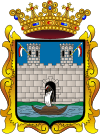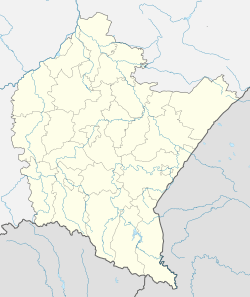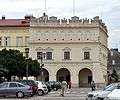Jarosław
Jarosław (Polish: [jaˈrɔswaf] (![]()
Jarosław | |
|---|---|
Town Hall and market square | |
 Flag  Coat of arms | |
 Jarosław  Jarosław | |
| Coordinates: 50°1′7″N 22°40′47″E | |
| Country | |
| Voivodeship | |
| County | Jarosław County |
| Gmina | Jarosław (urban gmina) |
| Government | |
| • Mayor | Waldemar Paluch |
| Area | |
| • Total | 34.46 km2 (13.31 sq mi) |
| Population (2014) | |
| • Total | 38,970 |
| • Density | 1,100/km2 (2,900/sq mi) |
| Time zone | UTC+1 (CET) |
| • Summer (DST) | UTC+2 (CEST) |
| Postal code | 37-500 |
| Car plates | RJA |
| Website | http://www.jaroslaw.pl |
History
The city was established on 1031 by Yaroslav the Wise, a grand prince of Kievan Rus'. It was granted Magdeburg rights by Polish prince Władysław Opolczyk in 1375.
The city quickly developed as important trade centre and a port on the San river, reaching the period of its greatest prosperity in 16th and 17th century, with trade routes linking Silesia with Ruthenia and Gdańsk with Hungary coming through it and merchants from such distant countries as Spain, England, Finland, Armenia and Persia arriving at the annual three-week-long fair on the feast of the Assumption. In 1574 a Jesuit college was established in Jarosław.
In the 1590s Tatars from the Ottoman Empire pillaged the surrounding countryside. (See Moldavian Magnate Wars, The Magnate Wars (1593–1617), Causes.) They were unable to overcome the city's fortifications, but their raids started to diminish the city's economic strength and importance. Outbreaks of bubonic plague in the 1620s and the Swedish The Deluge in 1655-60 further undermined its prominence. In the Great Northern War of 1700-21 the region was repeatedly pillaged by Russian, Saxon and Swedish armies, causing the city to decline further.
In the mid-eighteenth century, Roman Catholics constituted 53.7% of the population, members of the Greek Catholic Church 23.9%, and Jews 22.3%.[2]
Jarosław was under Austrian rule from the First Partition of Poland in 1772 until Poland regained independence in 1918. After the Second World War the city remained part of Poland. Poland's communist government expelled most of Jarosław's Ukrainian population, at first to Soviet territories and later to territories transferred from Germany to Poland in 1944-45.
Jewish Jarosław
The first Jews reportedly arrived in Jarosław in 1464. The first rabbi of Jarosław was Rabbi Nathan Neta Ashkenazi, in 1590. A year later, the new Council of Four Lands (Vaad Arba Aratzot) began convening in Jarosław, rotating the meeting with the city of Lwów (Lviv).
Until 1608 with a small Jewish community, religious facilities were not allowed. Still, Rabbi Solomon Efraim of Lontschitz (the author of "Kli Yakar"), a prominent and well known rabbi, lived here. By 1670 there was a large "government" synagogue created, although protested by the Christian community of the city. During attacks on the city by Tatars and Swedes, Jewish merchandise and sometimes homes were set on fire. In 1765, there were 1,884 Jews in the city and towns around it. A Jewish school was established sometime later. The famous rabbi Levi Isaac of Berdyczów (Berdychiv) studied in Jarosław circa 1760 and was called "the genius of Yeruslav". A fire in 1805 burnt down the old synagogue and a new one was established more according to tradition to replace it. The new synagogue was completed in 1811. A census taken in 1901 notes that Jews were 25% of the population: 5701 Jewish families.
In a story about Jacob Kranc told by Rabbi Jacob Orenstein around 1850, about the appointment of the Jarosław rabbi, Rabbi Orenstein had refused the appointment of Rabbi of Jarosław because it would be against his old uncle's appointment. The city council had already written his appointment and wished to express their sorrow for its cancellation. The Dubner Magid had just entered the city on a snowy winter day, and was taken directly to Orenstein's house, together with the city council, who happened to pass by him. But the walk up the steps was enough to create a moving speech, remembered years later, and accounted for in the book.
In 1921 the last rabbi was appointed, Rabbi Shmaiya HaLevi Steinberg. He wrote a book about the Jews of his town, and in the 1930s sent two copies to the National Hebrew Library in Jerusalem. These copies are the only surviving copies of the book after the Holocaust.
In September 1939, Jarosław was captured by Germans. Most of the Jews crossed the San river to the Soviet side and hid in the Carpathian mountains, including the elder rabbi and his family. Those that stayed were shot and killed by the German soldiers.
- Jarosław (Yaruslav) Hassidim in Modern day Israel
Sights
Landmarks
|
|
Notable people
|
|
Twin towns - sister cities
Jarosław is twinned with:[4]
|
Gallery
- A historical panorama of the city
- St. Nicholas church and Benedictine abbey
 Town Hall
Town Hall- Corpus Christi Church
- Juliusz Słowacki Street
 The Jarosław Museum
The Jarosław Museum Nicolaus Copernicus High School
Nicolaus Copernicus High School- Adam Mickiewicz Square
 Market Square
Market Square- Centre for Culture
- Church of the Holy Spirit
 Great synagogue
Great synagogue
See also
References
- "Population. Size and structure by territorial division" (PDF). stat.gov.pl. 2 June 2009. Retrieved 22 June 2014.
- J. Motylkiewicz. "Ethnic Communities in the Towns of the Polish-Ukrainian Borderland in the Sixteenth, Seventeenth, and Eighteenth Centuries". C. M. Hann, P. R. Magocsi ed. Galicia: A Multicultured Land. University of Toronto Press. 2005. p. 37.
- "Joseph Wilf, 'visionary' benefactor, dies at 91". New Jersey Jewish News - NJJN. Retrieved 23 December 2017.
- "Jarosław Official website - Partner Cities".

External links
| Wikimedia Commons has media related to Jarosław. |
